Center for Research Equipment
Center for Research Equipment Division of R&D Equipment Industry > Major Research Activities Home
Center for Research Equipment builds and operates cutting-edge research equipment, and develops new analytical methods to conducts creative research support and joint research with domestic and foreign companies, universities and research institutes.
1. Electron Microscopy & Spectroscopy Analysis
We identifies the characteristics of materials through structural analysis, electronic structure analysis, surface analysis, and thermal property analysis.
Main Research Field
[Atomic Level Structure / Chemical Analysis] Atomic Level Structure Analysis and Electronic Structure Analysis of Semiconductor and Nano Materials
- Atomic structure analysis / electronic structure of dielectric thin films
- Development of characterization analysis method suitable for the characteristics of semiconductor devices and implementing reliable research support of industry, academia, and research
[in-situ / 3D Tomo / Cryo-EM] Research Support of Nano-Bio Materials Using Korea's Only 1st HVEM and 2nd Bio-HVEM
- Depending on the external environment within the transmission electron microscope through various in-situ experiments
- Ultra-high resolution, three-dimensional structural analysis of thick biological samples
- High resolution 3D structural analysis for the protein/cell level through Cryo-EM analysis
[Surface analysis / Thermal analysis]
- Analysis of element type, composition ratio and chemical bonding state on the surface of the material through XPS / UPS
- Analyze thermal properties of materials such as thermal conductivity, specific heat, coefficient of thermal expansion, and thermal properties in cryogenic conditions as well as at room temperature (interface thermal resistance characteristics of laminated structural materials, etc.)
Representative Research Cases
3D Reconstruction and modeling of helical assembly of peptide programmable nanoparticles by electron tomography with high-resolution and tilting angle
- Biomaterials derived via programmable supramolecular protein assembly provide a viable means of constructing precisely defined structures. We present programmed superstructures of AuPt nanoparticles (NPs) on carbon nanotubes (CNTs) that exhibit distinct electrocatalytic activities. Surface cysteine residues of the peptides create AuPt-specific nucleation site, which allow for precise positioning of NPs onto helical geometries, as confirmed by 3-D reconstruction. This origami research with 3D tilting electron tomography function of Bio-HVEM for design and confirmation approach can be expanded to versatile fields to build sophisticated functional assemblies.
- Identifying the mechanism of PL efficiency improvement through surface analysis of organic-inorganic perovskite using atomic-level imaging/electron energy loss spectroscopy (J. Phys. Chem. Lett., 2019)
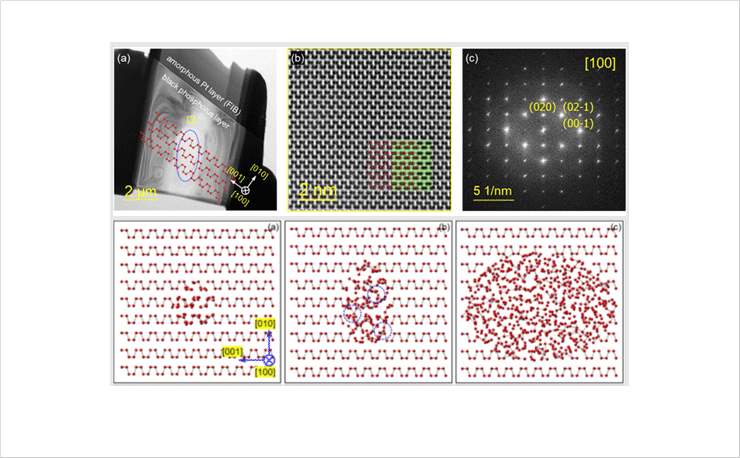 Investigation of the initial thermal disorder and decomposition mechanism of black phosphorus
Investigation of the initial thermal disorder and decomposition mechanism of black phosphorus
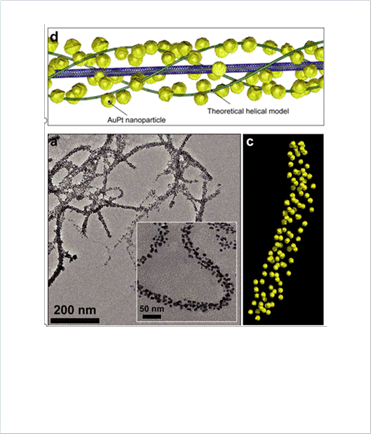 Electron tomography and 3D reconstruction of Peptide programmable nanoparticle superstructure through Bio-high voltage electron microscope
Electron tomography and 3D reconstruction of Peptide programmable nanoparticle superstructure through Bio-high voltage electron microscope
(Bio-HVEM).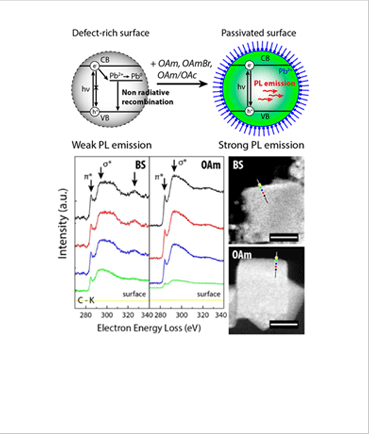 PL improvement Mechanism
PL improvement Mechanism
of Organic-Inorganic
Perovskite and surface analysis
Using EELS / STEM
2. Bio-Chemical Analysis
We establishes a joint research platform for characterization and image analysis of various biological materials (i.e., proteins, lipids and metabolites) and environmental harmful substances using advanced high-resolution research equipments (i.e., mass spectrometry, nuclear magnetic resonance, and magnetic resonance imaging) to conduct creative research collaborations.
Main Research Field
High-resolution mass spectrometry-based study for environmental and living harmful substances (i.e., aerosol particles, spilled oils, and active ricins) and proteins and metabolites in clinically relevant biological samples
- Development of an advanced platform for the characterization of fine aerosol and spilled oil-derived organic substances by using high-resolution mass spectrometry
- Development of a novel method to detect toxic active ricins in organic fertilizers
High-field nuclear magnetic resonance spectroscopy-based study for the structural characterization of biological molecules (proteins and natural products)
- Development of an advance platform for the characterization of 3D structure of biologically relevant proteins and their physico-chemical properties
High-field magnetic resonance imaging-based study for disease diagnosis and prediction
- MRI imaging-based ischemic injury index and immune cell tracking method development
Representative Research Cases
Development of an advanced platform for the characterization of fine aerosol (PM2.5)-derived organic substances by using ultra-high-resolution mass spectrometry
- To understand the chemical composition and formation mechanism of fine aerosols in the Arctic, the chemical and molecular compositions of the Arctic PM2.5-derived organic compounds were characterized using a 15 tesla FT-ICR mass spectrometer (Conducting the National Strategic Project‐Fine particle; Global Biogeochemical Cycles, 2019).
Identification of the structure of self-assembled molecular knots with 16 intersections using NMR spectroscopy
- Characterization of coordination-driven self-assembly of a molecular knot comprising 16 crossrings that mimics biomolecular and mechanical properties (Angewandte Chemie, 2018).
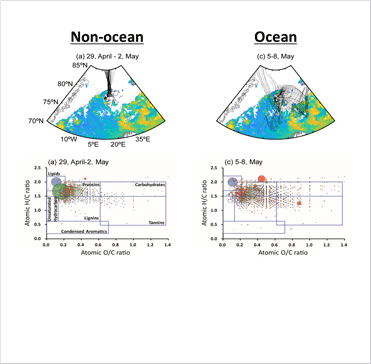 Characterization of Arctic aerosols in combination with arctic airmass back-trajectories and ocean chlorophyll conc.
Characterization of Arctic aerosols in combination with arctic airmass back-trajectories and ocean chlorophyll conc.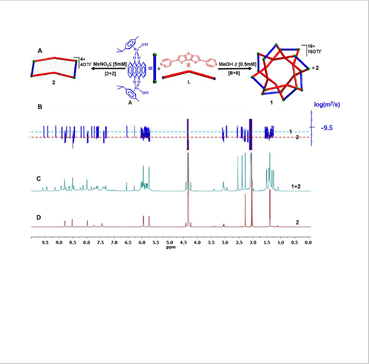 Investigation of
Investigation of
the formation mechanism of
self-assembled molecular knot
3. Earth & Environmental Analysis
We provides the analytical service for geological age dating, food authenticity and trace element & isotope measurement of the earth and environmental materials using the state-of-the-art mass spectrometer and natural radioactivity measurement system. Collaboratory researches in analytical sciences are progressing with the large-geometry secondary ion mass spectrometer.
Main Research Field
Analysis of isotope and trace element for earth and environmental materials
- Korea’s only one-stop service for geological age determination using SHRIMP and OSL facilities
- Nationally accredited analysis service in trace elements and natural radioactivity for soil and water
Natural radioactivity measurement of domestic agro-fisheries and industrial products and its authenticity test
- Radioactivity test of the import-export goods for people’s safety
- Development of analytical technique in origin analysis for agro-fisheries, airborne dust and cultural heritage
Representative Research Cases
Installation of world’s first high-resolution isotope microscope comprised of next-generation large geometry secondary ion mass spectrometer and quantitative imaging sensor
- In-situ isotope analysis for the small area of earth and environmental, high-tech, and bio materials.
Study for the formation of Precambrian basement using SHRIMP U-Pb age results
- SHRIMP U-Th-Pb ages of zircon and monazite from the migmatitic gneiss in Sancheong-Hadong area of Yeongnam Massif in Korea suggest that the low-P/high-T metamorphism concomitant with the anorthosite intrusion were prolonged to ca. 15 Ma and related with the final product of hot orogeny in North China Craton during Paleoproterozoic (ca. 1.85-1.95 Ga)
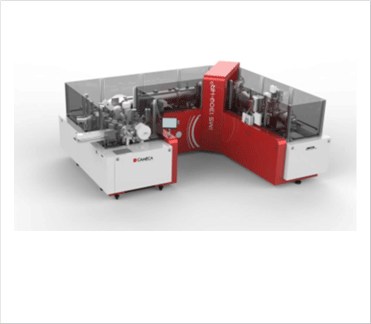 High-resolution isotope microscope combined with IMS1300-HR3 LG-SIMS and SCAPS quantitative image sensor
High-resolution isotope microscope combined with IMS1300-HR3 LG-SIMS and SCAPS quantitative image sensor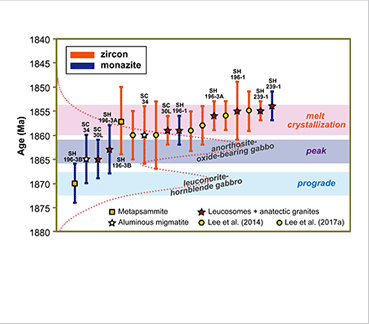 U-Pb age diagrams showing
U-Pb age diagrams showing
progressive low-pressure/high-temperature
metamorphism
4. Engineering Support
We supports the best research environment and the research result through the operation of smart-open-labs, helium liquefier supplies, ultra-precision processing tech shops and equipment maintenance.
Main Research Field
Technical support
- Maintenance and troubleshooting of research equipment.
- Consultation, design and production for the remodeling and development of research equipment.
- Professional technical training to foster research equipment maintenance personnel.
Smart Open Lab:
- Co-utilization of web / mobile based general equipment
- Self-analysis through equipment operation training
- Professional analysis technology transfer, analysis consultation and co-research
Ultra-precision tech-shop
- Operation of ultra-precision machining tech-shop
- Development of ultra-precision machining and metrology technique on freeform optics
- Development of ultra-precision machining and metrology technique on large-area optics
Helium liquefier supplies
- Helium liquefier supplies liquid helium to research equipment that requires cryogenic environments
- Low temperature related technical and business support
Representative Research Cases
Technical Support
- Modification of sample source for Nano-SIMS
- Support more than 200 cases per year
Smart Open Lab:
- Quipment training: More than 70 times per year (over 350 people)
- Autonomous analysis: More than 300 cases per year
Construction of Large-aperture Magneto-rheological Freeform surface finishing system
- 1.2 m Magneto-rheological freeform surface finishing system was constructed in 2019, and exchanging and support processing technology of ultra-precision optical components with the inside and outside the country institution (NOAO, The University of Arizona, KASI, KARI and Kyunghee University)



